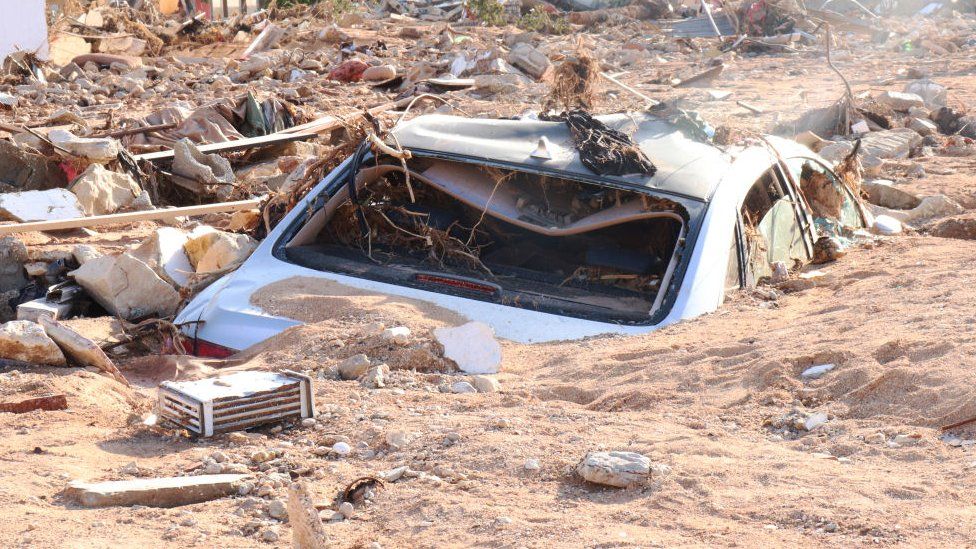How climate change worsens heatwaves, droughts, wildfires and floods
- Published

Extreme weather is becoming more frequent and more intense in many places around the world because of climate change.
Here are four ways climate change is linked to extreme weather.
1. Hotter, longer heatwaves
Even a small increase to average temperatures makes a big difference.
This is because the whole distribution of daily temperatures shifts to warmer levels, making hotter days more likely and more extreme.
Scientists use computer simulations to assess whether extreme weather events have been made more likely by warming caused by humans.
For example, the intense heatwaves that hit southern Europe and the southern US and Mexico in July 2023 would have been "virtually impossible" without human-caused climate change, according to the World Weather Attribution network (WWA).
But these events are no longer rare. If global warming reaches 2C above the pre-industrial period - before humans started burning fossil fuels at scale - these events are expected to happen every two to five years, the WWA warns.
In the UK, temperatures topped 40C for the first time on record in July 2022. This would have been extremely unlikely without climate change, the WWA says.
As well as happening more frequently, heatwaves are becoming longer and more intense in many places, including the UK.
This can happen as a result of heat domes, which are areas of high pressure where hot air is pushed down and trapped in place, causing temperatures to soar over large areas.
One theory suggests higher temperatures in the Arctic - which has warmed more than four times faster than the global average - are causing strong winds called the jet stream to slow, increasing the likelihood of heat domes.
2. Longer droughts
Linking climate change with specific individual droughts can be difficult. The availability of water depends on more than just temperature and rainfall.
But longer and more intense heatwaves can worsen droughts by drying out soil. This makes the air above warm up more quickly, leading to more intense heat.
Increased demand for water from humans, especially farmers, in hot weather puts even more stress on the water supply.
In parts of East Africa, there were five failed rainy seasons in a row between 2020 and 2022, as the region suffered its worst drought for 40 years.
Climate change has made droughts like this at least 100 times more likely, according to the WWA.
3. More fuel for wildfires
Fires happen naturally in many parts of the world. It's difficult to know if climate change has caused a specific wildfire to spread because other factors are also relevant, such as changing land use.
But climate change is making the weather conditions needed for wildfires to spread more likely, according to the UN's climate body, the IPCC.
Extreme and long-lasting heat draws more and more moisture out of the ground and vegetation.
These tinder-dry conditions provide fuel for fires, which can spread at an incredible speed, particularly if winds are strong.
Rising temperatures may also increase the likelihood of lightning in the world's northernmost forests, increasing the risk of fires.
Canada experienced by far its its worst wildfire season on record in 2023, with around 18 million hectares (45 million acres) burned.
Climate change more than doubled the likelihood of the extreme "fire weather" conditions in eastern Canada that allowed the fires to spread, according to the WWA.
Extreme wildfires are projected to become more frequent and intense in future across the globe, according to a recent report by the UN Environment Programme (UNEP). This is due to the the combined effects of shifting land use and climate change
The number of the most extreme fires may rise by as much as 50% by 2100, UNEP suggests.
4. More extreme rain
For every 1C rise in average temperature, the atmosphere can hold about 7% more moisture.
This can result in more droplets and heavier rainfall, sometimes in a shorter space of time and over a smaller area.
Parts of northern Libya were hit by devastating floods in September as a result of extreme rainfall and two major dam collapses. The heavy rainfall was made as much as 50 times more likely by climate change, according to the WWA.
The destruction was exacerbated by social and political instability in the country, which hampered efforts to adequately prepare for and respond to such storms - for example by maintaining dams.
Not all extreme rainfall events can be attributed to climate change, as other factors including changes to land use can play a role. For example, the WWA says that climate change only had a "limited" role in the heavy rainfall that hit northern Italy in May 2023.
But globally, the frequency and intensity of heavy rainfall events has increased over most land regions due to human activity, according to the IPCC.
And heavy precipitation will generally become more frequent and intense with further warming, the IPCC says.